OCZ Vertex 3 MAX IOPS & Patriot Wildfire SSDs Reviewed
by Anand Lal Shimpi on June 23, 2011 4:35 AM ESTAnandTech Storage Bench 2011
Last year we introduced our AnandTech Storage Bench, a suite of benchmarks that took traces of real OS/application usage and played them back in a repeatable manner. I assembled the traces myself out of frustration with the majority of what we have today in terms of SSD benchmarks.
Although the AnandTech Storage Bench tests did a good job of characterizing SSD performance, they weren't stressful enough. All of the tests performed less than 10GB of reads/writes and typically involved only 4GB of writes specifically. That's not even enough exceed the spare area on most SSDs. Most canned SSD benchmarks don't even come close to writing a single gigabyte of data, but that doesn't mean that simply writing 4GB is acceptable.
Originally I kept the benchmarks short enough that they wouldn't be a burden to run (~30 minutes) but long enough that they were representative of what a power user might do with their system.
Not too long ago I tweeted that I had created what I referred to as the Mother of All SSD Benchmarks (MOASB). Rather than only writing 4GB of data to the drive, this benchmark writes 106.32GB. It's the load you'd put on a drive after nearly two weeks of constant usage. And it takes a *long* time to run.
1) The MOASB, officially called AnandTech Storage Bench 2011 - Heavy Workload, mainly focuses on the times when your I/O activity is the highest. There is a lot of downloading and application installing that happens during the course of this test. My thinking was that it's during application installs, file copies, downloading and multitasking with all of this that you can really notice performance differences between drives.
2) I tried to cover as many bases as possible with the software I incorporated into this test. There's a lot of photo editing in Photoshop, HTML editing in Dreamweaver, web browsing, game playing/level loading (Starcraft II & WoW are both a part of the test) as well as general use stuff (application installing, virus scanning). I included a large amount of email downloading, document creation and editing as well. To top it all off I even use Visual Studio 2008 to build Chromium during the test.
The test has 2,168,893 read operations and 1,783,447 write operations. The IO breakdown is as follows:
| AnandTech Storage Bench 2011 - Heavy Workload IO Breakdown | ||||
| IO Size | % of Total | |||
| 4KB | 28% | |||
| 16KB | 10% | |||
| 32KB | 10% | |||
| 64KB | 4% | |||
Only 42% of all operations are sequential, the rest range from pseudo to fully random (with most falling in the pseudo-random category). Average queue depth is 4.625 IOs, with 59% of operations taking place in an IO queue of 1.
Many of you have asked for a better way to really characterize performance. Simply looking at IOPS doesn't really say much. As a result I'm going to be presenting Storage Bench 2011 data in a slightly different way. We'll have performance represented as Average MB/s, with higher numbers being better. At the same time I'll be reporting how long the SSD was busy while running this test. These disk busy graphs will show you exactly how much time was shaved off by using a faster drive vs. a slower one during the course of this test. Finally, I will also break out performance into reads, writes and combined. The reason I do this is to help balance out the fact that this test is unusually write intensive, which can often hide the benefits of a drive with good read performance.
There's also a new light workload for 2011. This is a far more reasonable, typical every day use case benchmark. Lots of web browsing, photo editing (but with a greater focus on photo consumption), video playback as well as some application installs and gaming. This test isn't nearly as write intensive as the MOASB but it's still multiple times more write intensive than what we were running last year.
As always I don't believe that these two benchmarks alone are enough to characterize the performance of a drive, but hopefully along with the rest of our tests they will help provide a better idea.
The testbed for Storage Bench 2011 has changed as well. We're now using a Sandy Bridge platform with full 6Gbps support for these tests. All of the older tests are still run on our X58 platform.
AnandTech Storage Bench 2011 - Heavy Workload
We'll start out by looking at average data rate throughout our new heavy workload test:
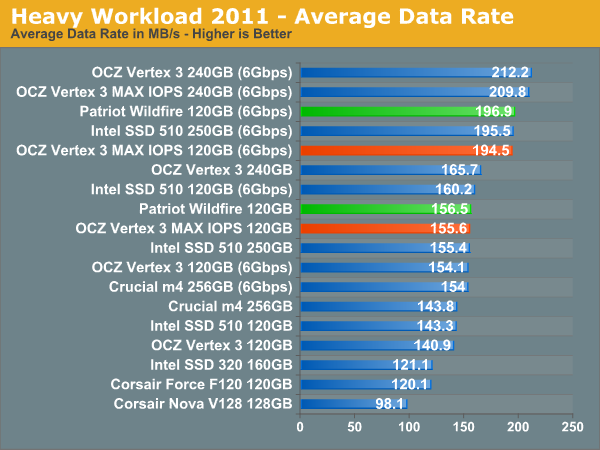
The breakdown of reads vs. writes tells us more of what's going on:
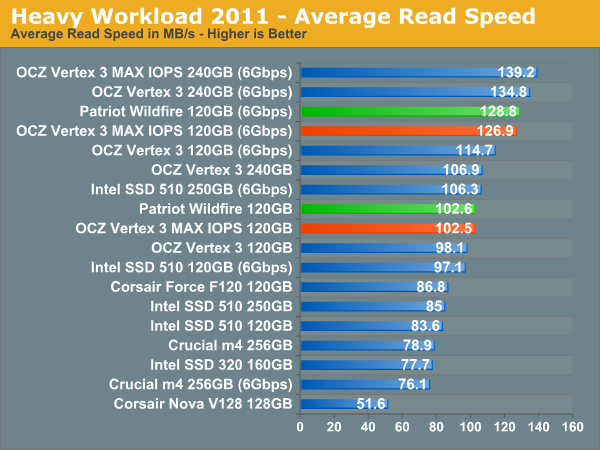
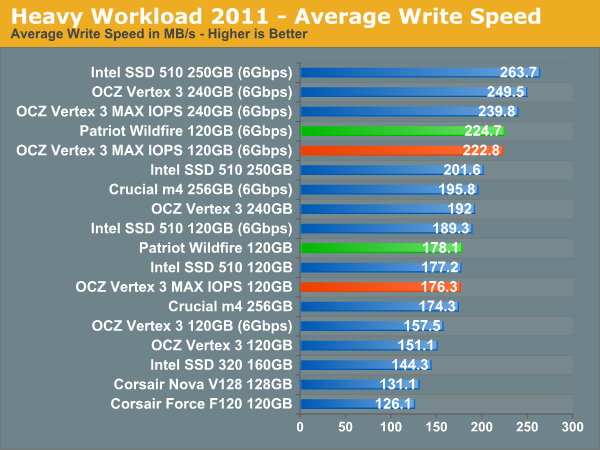
The next three charts just represent the same data, but in a different manner. Instead of looking at average data rate, we're looking at how long the disk was busy for during this entire test. Note that disk busy time excludes any and all idles, this is just how long the SSD was busy doing something:
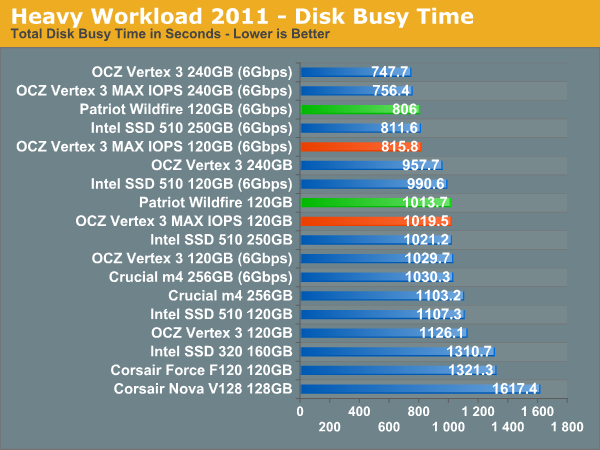
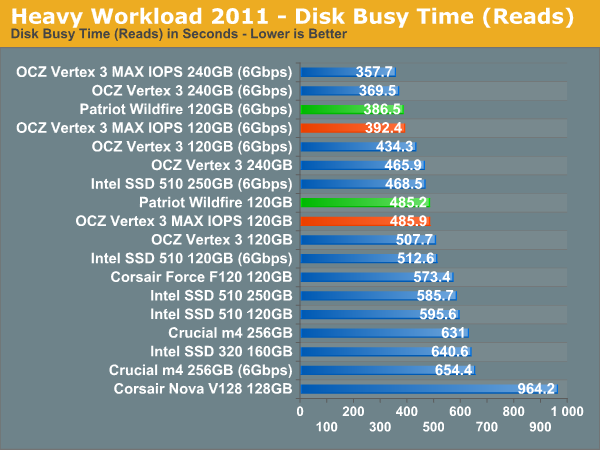
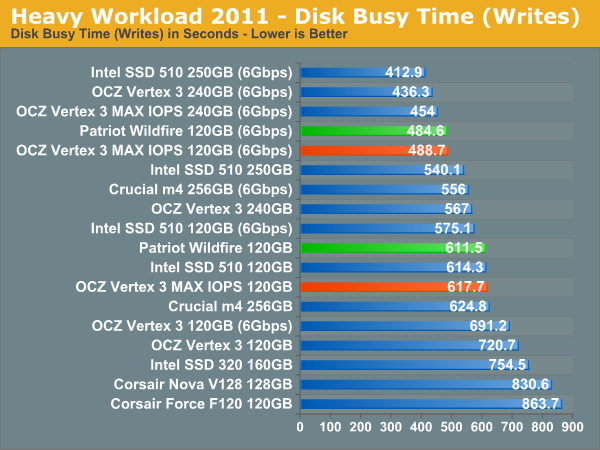










112 Comments
View All Comments
GullLars - Thursday, June 23, 2011 - link
I noticed the clear winner at your 4KB random read (QD3) test has been cleared from the chart. The C300 pushes over 90MB/s while the second highest, and the highest in this cart, is Vertex 3 240GB with 68MB/s. I feel this is worth noting, as the SF-2281 drives generally win with a good margin in many tests, but loose to a more than year old drive in small random reads at low queue depths.Bannon - Thursday, June 23, 2011 - link
Thanks for another good review Anand. I've been following the discussions in the Corsair and OCZ forums and while I'm interested in the super-fast speeds of the new SandForce drives I'm leery because of the problems a percentage of their customers are having. So, I was considering a 256GB Crucial M4 drive which seemed to do well in your review but was surprised when you recommended the Intel 510 drive as an alternative. Do you have concerns with the M4?ocz2004 - Thursday, June 23, 2011 - link
Hello everyone, as my first post in this thread let me identify myself as an OCZ employee. I’d like to thank everyone for their comments. Positive or negative, we appreciate all the feedback and take it very seriously throughout the organization. We continue to see a very small percentage of users with the BSOD issue but have made addressing this a high priority, and encourage any customers that have this or any issues to contact our customer service team. We have and will continue to work closely with SandForce and our platform partners for a final fix, and have spearheaded this effort among all manufacturers that utilize a SF solution. As mentioned in our previous public statement, we are also working on optimizations to the base code to minimize any performance delta associated with the temporary workaround. Thank everyone again for your support and feedback, and we will continue to work diligently on providing both premium performing and reliable SSDs to all our valued customers. We are willing to go above and beyond to make our customers happy; for anyone that is having this issue please contact support at drego @ ocz dot comtecsi - Thursday, June 23, 2011 - link
From Anand's comments:"It turns out that although the move from a hard drive to a decent SSD is tremendous, finding differences between individual SSDs is harder to quantify in a single real world metric...The best values in SSDs are going to be last year's models without a doubt."
It appears that the best desktop SSD value--by far--is grabbing a 64GB SATA II boot/app drive (paired with a big HD), which are often rebated to ~$70. Although SATA III and 120GB/240GB look great on a specialized SSD racetrack, in the real world the performance difference appears to be a 5-10%, while paying just 30% of the $250 cost for a SATA III 120GB drive.
Does this make sense or am I missing something? I was getting quite excited about SATA III and all the fawning over the Vertex 3, but this enthusiasm seems misplaced.
Impulses - Thursday, June 23, 2011 - link
Only issue with that is that after formatting and installing the OS, a 64GB SSD doesn't leave you a lot of extra space... Depending on your needs that may or may not be an issue. I got an 80GB Intel X25-M for my desktop last year and it's a little tight, I have the luxury of having enough space for a couple of games but I do rotate which ones I have on it... I'm looking at 120GB drives but I'm waiting for prices to come down a little.I got a 40GB X25-V for my netbook tho and it's just for that kinda system... Win7 and the basic kind of programs that I use on my netbook all fit fine within <25GB, and with only 1.5GB of RAM the size of the hibernate file isn't a big concern. Still got enough space for a couple of movies when I travel.
FunBunny2 - Thursday, June 23, 2011 - link
Over on Postgresql-performance, for one, there is not much love for anything less than full blown cap-backed SSDs, and even then, when used for database logs (not necessarily a good use of an SSD) 18 months is about the lifetime.So, using highly normalized (BCNF, which you shouldn't have to look up) X00 gig databases only on SSD (no HDD for logs and such) is a real torture test. Random access in a real world application. Oracle and MS have them. TPC, of course, has a bunch.
jdmstl - Thursday, June 23, 2011 - link
I had a problem with the Vertex 3 240GB in a new Thinkpad W520. The bluescreen occurred at relatively light or idle usage, but seemed to have nothing to do with power save features. I tried disabling all such features in the bios, as well as a number of logical software fixes to no avail.Finally, I simply returned the drive to Microcenter for a refund rather than deal with the issues. I never posted my problems to OCZ, although I read the related forum posts for clues.
I suspect that many people did the same, so I would not trust any defect rate figures based on number of forum posts. It would be more accurate to check the return rate, but I suspect that many people just ignore the BSODs and live with it without reporting any issue, assuming it will all work out eventually.
OCZ tries to deny or downplay issues without taking full responsibility. They did the same thing with JMicron controller problems a few years ago. (Not that any other brands were more honest or forthcoming.)
I think I will stick with Intel from now on, although I had good luck with 4 of the original Vertex Indilinx drives that are still running fine in my home desktop PCs.
jwilliams4200 - Friday, June 24, 2011 - link
OCZ is definitely the leader when it comes to their propaganda machine. It seems even Anand has gotten brainwashed by it.Concillian - Friday, June 24, 2011 - link
It really helps to read that page to put the performance picture in perspective. This kind of thing is difficult to get a feel for when looking at reviews.It's easy to tell which is faster from benchmarks, but it's not always easy to tell how much that speed will translate into actual perceivable improvement for daily workloads.
I think you should throw in a few "vs. rotating storage" charts in every SSD review just to help demonstrate the performance differences to those contemplating the jump to SSD. Many of your readers have made the jump and are looking at SSDs vs. SSDs, but I'll bet a fair amount are still looking at the value vs. a hard drive and haven't necessarily seen the history of all the articles that show these differences.
cactusdog - Friday, June 24, 2011 - link
I respect Anands opinions but the timing of his reviews and comments(regarding OCZ) makes it seem he is working with OCZ. Like he wont say anything negative unless OCZ have already addressed it.Its strange this review hit just after the new firmware 2.09 was released. The 2.09 firmware that is supposed to fix any BSOD issues.
Going back over previous reviews, Anand never mentioned any of the user complaints about slower 25nm nand (and the use of slower hynix or second rate Spectek nand) until AFTER OCZ had put out an official statement about it. Until OCZ had promised to swap drives and promised not to use dodgy nand again.
The point is Anand seems to have a direct line to OCZ and he will not address users concerns until AFTER OCZ has officially recognised it in some way.